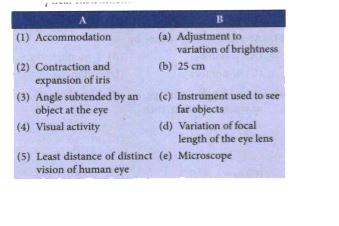Define resolving power of an optical instrument.
Step-by-Step Solution
1. Understanding the Concept: The resolving power of an optical instrument refers to its ability to distinguish between two closely spaced objects. When two objects are very close together, they may appear as a single object to the observer unless the instrument has sufficient resolving power.
2. Visualizing the Scenario: Imagine two objects placed near each other. If viewed from a distance without any optical aid, they may merge into one image. However, using an optical instrument (like a microscope or telescope) allows us to see these objects as separate entities.
3. Defining Resolving Power: The resolving power is defined as the ability of the optical instrument to separate the images of two objects. If the instrument can display the images of both objects distinctly, it has good resolving power.
4. Mathematical Representation: The resolving power can be mathematically expressed in terms of the limit of resolution (D). The limit of resolution is the minimum distance (D) at which two objects can be distinguished as separate.
5. Final Definition: Therefore, the resolving power (RP) of an optical instrument is given by the formula:
Resolving Power (RP)=1D
where D is the limit of resolution in meters. This means that the resolving power is inversely proportional to the limit of resolution.
Resolving Power (RP)=1D
where D is the limit of resolution in meters. This means that the resolving power is inversely proportional to the limit of resolution.
Topper's Solved these Questions
- WAVE OPTICALBOOK - MODERN PUBLICATIONCHAPTER - WAVE OPTICALEXERCISE - Revision Exercises (Additional Questions)
12 Videos
- WAVE OPTICALBOOK - MODERN PUBLICATIONCHAPTER - WAVE OPTICALEXERCISE - Revision Exercises (Fill in the Blanks)
10 Videos
- WAVE OPTICALBOOK - MODERN PUBLICATIONCHAPTER - WAVE OPTICALEXERCISE - Higher Order Thinking Skills & Advanced Level (QUESTIONS WITH ANSWERS)
8 Videos
- SEMICONDUCTOR ELECTRONICS METERIALS DEVICES AND SIMPLE CIRCUITS BOOK - MODERN PUBLICATIONCHAPTER - SEMICONDUCTOR ELECTRONICS METERIALS DEVICES AND SIMPLE CIRCUITS EXERCISE - CHAPTER PRACTICE TEST FOR BOARD EXAMINATION
12 Videos
Similar Questions
Knowledge Check
Assertion: Diffraction limits the resolving power of an optical instrument.
Reason: In diffraction, the fringes of minimum intensity are perfectly dark.AAssertion is True, Reason is True, Reason is a correct explanation for AssertionBAssertion is True, Reason is True, Reason is not a correct explanation for AssertionCAssertion is True Reason is False.DAssertion is False, Reason is True.Resolving power of an optical instrument is associated with
AdiffractionBpolarisationCscattering of lightDinterference
Optical instruments
View SolutionOptical instruments
View SolutionHow is resolving power of an optical instrument related to wavelength of light ?
View SolutionOptical Instruments
View SolutionOptical Instruments


View SolutionResolvingpower of an optical instrument is the ability of the instrument to………….or………..the images of………… .
View Solution
